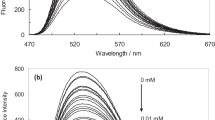Summary
Polyinosinic acid [poly(I)] was studied by a variety of techniques and together with the results in the literature the following structures are proposed.
-
1.
CD spectra of poly(I) as a function of ionic strength, temperature andpH show the existence of three main forms. At neutral pH and low ionic strength (below 0.1 M NaCl) at 3 °C or 20 °C poly(I) is a single-stranded poorly stacked helix. At 3 °C above 0.6 M NaCl poly(I) forms a multi-stranded (probably four-stranded) parallel left-handed helix. At 20 °C this structure is not completely formed. Between these extremes of ionic strength mixtures of the two forms are present which evolve differently with time, depending on ionic strength and temperature.
-
2.
The acid titration of poly(I) shows three regions as a function of ionic strength, following the same pattern as the CD spectra. The ionic strength dependence of thepK. (∼1.5) above 0.6 M NaCl suggests, but does not prove that N7 of the hypoxanthines may be implicated in the hydrogen-bonding scheme. Similarly, at high ionic strength methylation on N7 is greatly reduced in rate and extent.
-
3.
It is shown that the X-ray fiber pattern of Rich could be interpreted by a fourstranded helix withM=23/2 using a hydrogen bond between N1 and N7 between neighbouring bases.
Similar content being viewed by others
References
Brahms, J., Sadron, G.: Ionic and hydrogen bond interactions contributing to the conformational stability of polynucleotides. Nature212, 1309 (1966).
Chantot, J. F., Sarocchi, M. Th., Guschlbauer, W.: Physico-chemical properties of nucleosides. 4. Gel formation by guanosine and its analogues. Biochimie53, 347 (1971).
Chantot, J. F., Guschlbauer, W.: Physico-chemical properties of nucleosides. 5. Mechanism of gel formation by guanine nucleosides. In: The Purines. Jerusalem Symp. Quantum Chem. and Biochem.4, 205 (1972).
Clauwaert, J., Stockx, J.: Interactions of polynucleotides and their components. I. Dissociation constants of the bases and their derivatives. Z. Naturforsch.23b, 25 (1968).
Formoso, C., Tinoco, I.: Minor nucleosides in RNA: Optical studies of dinucleoside phosphates containing inosine. Biopolymers10, 531 (1971).
Geliert, M., Lipsett, M. N., Davies, D. R.: Helix formation by guanylic acids. Proc. Natl. Acad. Sci. U.S.48, 2013 (1962).
Gromova, E. S., Guschlbauer, W., Holý, A.: Oligonucleotide conformations. 2. Optical studies on 8-bromoguanylyl-3′-5′-8-bromoguanosine. FEBS-Letters26, 176 (1972).
Guschlbauer, W., Courtois, Y.:pH induced changes in optical activity of guanine nuoleosides. FEBS-Letters1, 183 (1968).
Guschlbauer, W., Frič, I., Holý, A.: Oligonucleotide Conformations 1. Optical studies on GpU analogues with modified undine residues. Europ. J. Biochem.31, 1 (1972).
Hall, C. E.: Electron microscopy of polynucleotides. Ann. N. Y. Acad. Sci.81, 723 (1959).
Haselkorn, R.: The conformation of polyinosinic acid in solution. Ph. D. Thesis, Harvard University, Chapter II, p. 9–70 (1959).
Harrington, W. F., Karr, G. H.: Collagen structure in solution. II. Analysis of refolding kinetics in terms of nucleation and growth processes. Biochemistry9, 3725 (1970).
Hinz H.-J., Haar, W., Ackermann Th.: Experimental thermodynamics of the helixrandom coil transition. III. Determination of the transition enthalpies of the helical complexes poly(I+C) and poly(I) in solution. Biopolymers9, 923 (1970).
Lumry, R., Rajender, S.: Enthalpy-entropy compensation phenomena in water solutions of proteins and small molecules: a ubiquitous property of water. Biopolymers9, 1125 (1970).
Michelson, A. M., Pochon, P.: Polynucleotide analogues VII. Methylation of polynucleotides. Bioohim. et Biophys. Acta114, 469 (1966).
Michelson, A. M., Massoulié, J., Guschlbauer, W.: Synthetic polynucleotides. Progr. Nucleic Acid Bes. Mol. Biol.6, 83 (1967).
Michelson, A. M., Monny, C., Kapuler, A.: Poly-8-Bromo-guanyIic acid. Biochim. et Biophys. Acta217, 7 (1971).
Miles, H. T.: Tautomeric forms in a polynucleotide helix and their bearing on the structure of DNA. Proo. Natl. Acad. Sci. U.S.47, 791 (1961).
Millar, D., Grafius, M. A.: A polyl cryoform. Currents Mod. Biol.1, 121 (1967).
Mitsui, Y., Langridge, R., Shortle, B. E., Cantor, C. R., Grant, R. C., Kodama, M., Wells, R. D.: Physical and enzymatic studies on poly d(I-C). poly d(I-C), an unusual double helical DNA. Nature228, 1166 (1970).
Pörschke, D., Eigen, M.: Cooperative nonenzymic base recognition. III. Kinetics of the helix-coil transition of the oligoribouridylic · oligoriboadenylic acid system and of oligoriboadenylic acid alone at acidpH. J. Mol. Biol.62, 361 (1971).
Pochon, F., Michelson, A. M.: Equilibre dans la conformationanti-syn des acides oligoinosiniques en solution. Compt. rend. Acad. Sci. Paris270, 1829 (1970).
Rich, A.: The molecular structure of polyinosinic acid. Biochim. et Biophys. Acta29, 502 (1958).
Sarkar, P. K., Yang, J. T.: Optical activity and the conformation of polyinosi acid and several other polynucleotide complexes. Biochemistry4, 1238 (1965).
Souleil, C., Panijel, J.: Immunochemistry of polyribonucleiotides. Study of polyriboinosinic and polyriboguanylic acids. Biochemistry7, 7 (1968).
Thiele, D., Guschlbauer, W.: Polynucleotides protonés. VII. Transitions thermiques entre differents complexes de l'acide polyinosinique et de l'acide polycytidylique en milieu acide. Biopolymers8, 361 (1969).
Tinoco, I.: The optical properties of polynucleotides. J. chim. phys.65, 91 (1968).
Tougard, P., Chantot, J. F., Guschlbauer, W.: Nucleoside conformations 10. An X-ray fiber diffraction study of the gels of guanine nucleosides. Biochim. Biophys. Acta308, 9 (1973).
Vetterl, Vl., Guschlbauer, W.: Protonated polynucleotide structures XI. Polyadenylic acid at high ionic strength. Arch. Biochem. Biophys.148, 130 (1972).
Author information
Authors and Affiliations
Additional information
To the memory of Prof. Dr. Margarethe Janke (Wien) (1897 to 1972).
Ce travail fera partie de la Thèse de Doctorat-ès-sciences naturelles (Université Paris-Sud, Centre d'Orsay) de Danielle Thiele.
Rights and permissions
About this article
Cite this article
Thiele, D., Guschlbauer, W. The structures of polyinosinic acid. Biophysik 9, 261–277 (1973). https://doi.org/10.1007/BF01184691
Received:
Issue Date:
DOI: https://doi.org/10.1007/BF01184691




